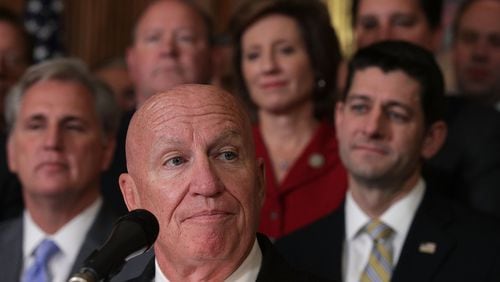Recent claims PolitiFact checked out included a claim by a Georgia candidate for governor on the cost of child care and claims by two prominent Republicans in Congress on the GOP tax-overhaul plan. Here are summaries of our findings. Full versions can be found at www.politifact.com.
“The average cost for infant care in GA is almost $7,700/yr – more than average in-state college tuition.”
— Stacey Abrams on Wednesday, Nov. 15, 2017 in a post on Twitter
The estimates Abrams uses come from Child Care Aware of America's 2015 "Parents and the High Cost of Child Care" report. The report calculates the averages of care offered at a facility and care offered at someone's home. The $7,644 the EPI cites is the more expensive type, care offered at a facility. According to the report, the average cost of child care in a caregiver's home in Georgia is $5,980 a year.
According to EPI, Georgia's average in-state tuition estimate was taken from a 2014 survey conducted by the National Center of Education Statistics, a division of the U.S. Education Department. The total cost of tuition and required fees in a public university in Georgia averages out to $6,614 a year.
So Abrams’ number is accurate if the comparison is between child care at a facility and in-state college tuition. But it’s not correct if the comparison is with child care provided in a home.
Our ruling
The statement is partially accurate but leaves out important facts. We rate this statement Half True.
In the House Republican bill, “70 percent of the tax relief goes to those families making less than 200,000.”
— Rep. Kevin Brady, R-Texas, on Sunday, Nov. 26, 2017 in an interview with Fox News’ Maria Bartiromo
When we took a closer look at this claim by Rep. Kevin Brady, R-Texas, chairman of the tax-writing House Ways and Means Committee, we found his statistic somewhat misleading.
Brady’s office pointed us to one chart in particular that shows those below the $200,000 threshold get 69 percent of the benefits, while those above $200,000 get 31 percent.
That's in line with what Brady said — but the talking point is cherry-picked.
First, the ratio of gains above and below $200,000 change over time. By 2025, households below $200,000 get 52 percent, and by 2027, they get 51 percent — still a majority, but significantly below Brady’s 70 percent figure.
The bigger issue concerns what kinds of income are counted in the chart Brady used.
As we’ve found in a previous fact-check, the chart Brady used addresses just the personal income tax changes in the bill. However, the bill would also change how other types of taxes are levied, including corporate and estate taxes.
Our ruling
Brady’s claim that “70 percent of the tax relief goes to those families making less than 200,000” is only accurate if you look at the individual income tax portions of the House bill. Once you factor in tax changes related to business income, which tend to benefit wealthier taxpayers, the share earned by those under $200,000 is actually 58 percent in 2019, falling to 50 percent in 2027. And if you factor in the impact of the estate tax, it would be as low as 54 percent initially and 31 percent by 2027.
We rate the statement Half True.
“Close to half of the voters in America, the only tax they pay is the payroll tax.”
— Sen. Marco Rubio, R-Fla., on Sunday, Nov. 26, 2017 in an interview
Sen. Marco Rubio, R-Fla., has worked to persuade Republican leaders to expand the child tax credit so the tax overhaul benefits more working families. He wants to make the credit refundable against payroll taxes.
Rubio’s exact point is a stretch, but experts said he “has the spirit of the situation right.”
We were not able to identify an exact percentage of Americans (or voters) whose only tax paid is the payroll tax, and Rubio’s office didn’t provide any evidence to back his specific claim.
We did find one estimate, from the Urban Institute-Brookings Institution Tax Policy Center, that 44 percent of households paid no federal income tax in 2016. In a subsequent report using the same estimates, the center said about 60 percent of people who paid no income tax still worked and owed payroll taxes.
Based on the center’s estimates, this means about a quarter of all households pay payroll taxes, but not income taxes. That’s half as many as Rubio said.
Our ruling
Rubio garbled the specific percentage of Americans who pay only payroll taxes, as the closest estimate we could find shows that about one-quarter of all households in 2016 paid the payroll tax but not the income tax.
However, experts said the point Rubio was trying to make — that for most people, the burden of the payroll tax exceeds that of the income tax — is correct.
We rate this claim Half True.
About the Author






